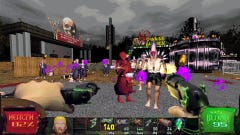Miasma Chronicles review: this tactically sound turn-based post-apocalypse is short on fresh ideas
Back on the grid
Swedish developers The Bearded Ladies certainly have a type. If you’ve played the memorably odd Mutant Year Zero or the largely forgettable Corruption 2029, you’ll know it by now – a blend of real-time stealth and turn-based tactics, where you quietly pick off stragglers from enemy squads before confronting the rest in a team scrap. Now here’s Miasma Chronicles, the Ladies’ third effort, and let’s just say they’re clearly happy to stick with what they know.
While the patterns of play are to a great extent the same, though, Miasma Chronicles is a more ambitious project. Addressing criticisms that those earlier games weren’t substantial enough, it’s a broader, denser beast, in which you could easily spend twice as long – 30 hours or so – seeing all the sights and shooting the nasties that populate them. That means there’s a lot more space available for this game to coax out varied strategies and introduce more elements, which is great. But it also means the weaker elements of the formula are left more exposed, which isn’t.
For one, the all-new post-apocalyptic premise here has a lot more ground to cover. 140 years after a civilisational collapse, America is clogged with miasma, a sort of malignant plague of iron filings that swarms in vortexes and gets everywhere, destroying or mutating living organisms. You are Elvis, a young man scratching an existence in a polluted mining town, and owner of a mysterious mechanical glove. This heavy handwear was left for Elvis by his mother, who disappeared behind a wall of miasma some years back, challenging him to use the glove’s power to break through and track her down.
It’s an intriguing enough start, and coupled with environments choked by thousands of swirling miasma particles, produces a suitably oppressive atmosphere. It all looks rather impressive too, with its detailed rendering of scrap metal settlements and crumbling monuments of human history. Plus, there’s a guilty pleasure to be had poking between skeletal remains in these derelict buildings, like the shell of an airport nested in a graveyard of broken planes.
Even if it’s well drawn, though, there’s not much here to elevate the scenario above end-of-days clichés. On one hand, the world feels lacking as a believable place – like, what do people eat, for example, given the absence of vegetation or animals? On the other hand, attempts to treat the fiction as a springboard for comedy fall flat. Jokes clunk, while satire, such as the presence of a vampiric elite known as the First Family, never gets above a kind of dull hum. Elvis’ role as laidback ordinary Joe turned potential hero also fails to entertain. Rather than a wisecracking Bruce Willis type, he just sounds drowsy.
.jpg?width=690&quality=80&format=jpg&auto=webp)
On top of that, there’s an awkward racial dynamic in the cast, especially in the first act, as Elvis and companion Jade effectively become white saviours to a predominantly black community, who soon need Elvis to solve all their problems. And while Elvis and Jade are quite grounded characters, the final part of your initial trio, Elvis’ robot ‘brother’ Diggs, is given a clownish, macho persona tied to an overtly African American voice, spouting off one-liners about ‘bling’ that make no sense in this context. Whatever the thinking was here, the result feels horribly dated.
The otherwise routine beats of the plot bleed into some very uninspired mission design too. The writing is on the wall when your first quest begins – you need a power core to recharge your glove, but the person who has a power core needs a torque jammer, so if you scratch their back… From there, both main and optional side missions stick religiously to this format of trading favours – collect or rescue A from enemy-infested buildings to swap for B. Most relationships with NPCs begin and end there.
Of course, once you’re waist-deep in combat encounters, as you will be for the bulk of your time in Miasma Chronicles, concerns about why you’re there quickly fade. Instead, you’ll be focused on dealing with the deadly things in front of you, from miasma monsters and robots to mutant frog people and, well, just people. For the most part, the systems here carry over intact from Mutant Year Zero and Corruption 2029, in that you carefully plan where and when to start a scrap, and then the fights themselves proficiently reprise the grid, cover and action point rules of genre classics such as XCOM.
.jpg?width=690&quality=80&format=jpg&auto=webp)
.jpg?width=690&quality=80&format=jpg&auto=webp)
.jpg?width=690&quality=80&format=jpg&auto=webp)
Yet given that these are now such tried and tested systems, you have to wonder why certain creases haven’t been ironed out. Pre-battle stealth kills, for instance, still aren’t really a means of making fights easier so much as making them manageable at all, since enemy numbers are too great to take on right away. As such, slowly creeping around the large areas containing enemy patrols, picking off isolated weaker targets with silent weapons, is a necessity rather than a tactic, and if you accidentally alert the whole squad before you’re done, you may as well reload your save.
Then, once you’re in battle, beware of some erratic results. The tutorials set the pace here, teaching some basics while leaving out others, then further sloppiness follows in little UI glitches that confuse decision making, often because displays fail to update as you consider different weapons or skills. Or occasionally, the promised outcome of an attack simply doesn’t happen. Sure, for the most part, you can grow accustomed to these foibles or circumvent them with frequent saving. But it would be a massive gamble to attempt the game’s equivalent of Ironman mode as things stand (even Normal mode includes one sequence of five battles during which all saving is disabled).
"Yet given that these are now such tried and tested systems, you have to wonder why certain creases haven’t been ironed out"
And until you do get used to the quirks, in the opening hours of the game they combine with some rather stingy design to produce a needling experience. Levelling up, for example, rewards you with a skill point to spend on new abilities, but very few abilities cost only one skill point, and since you level up maybe about once an hour, you’ll be saving your pennies for a long time before making significant headway into each character’s tree. Then when you do unlock a skill, cooldown times between uses are excessive (even overwatch takes three turns), and even carry over between battles. Add to that the inflated prices of grenades, health packs and alternate weapons in shops and you may conclude that Miasma Chronicles is happy to show you its toys, but doesn’t really want you to play with them.
.jpg?width=690&quality=80&format=jpg&auto=webp)
Having said all that, however, once you do get into the tactical meat of the game, especially after the first third, Miasma Chronicles is often as enthralling and deliciously challenging as you may hope. Once every character (a couple more join later who can be swapped in to replace Jade) has a few skills and passive boosts unlocked, those long cooldowns aren’t quite so punitive. Instead, you plan rotations between the members of your three-strong squad, taking it in turns to cover overwatch, say, or ripping a tough guy’s armour away with one shot so the others can make hay with ordinary attacks.
Meanwhile, the shape of each level and arrangement of furniture within provides the perfect show floor for your efforts. Stealth mode really comes into its own when you’re touring a location deciding where you’ll make your stand when it all kicks off, scoping out strong cover points, opportunities for height advantage and so on. Few tactics games grant you this kind of room to consider your approach. And when battle commences, there’s a lot of scope to use the architecture in creative ways, retreating down corridors to create bottlenecks, say, or executing flanking manoeuvres. Although more powerful enemies are usually quite proficient at avoiding obvious traps, forcing you to take extra risks to finish them off.
At the core of Miasma Chronicles, then, is a nugget of precious metal. It demonstrates a strong understanding of what makes turn-based tactics games tick, and when you get down to the nitty-gritty, it’s full of the knife-edge decisions and risk-reward gambits the genre is renowned for. But around that core there’s too much that doesn’t quite fit, or isn’t quite up to snuff. If The Bearded Ladies are going to stick to type in the future, their balance of stealth, tactics and post-apocalyptic fiction could do with a new strategy.
This review is based on a review build of the game provided by the publisher The Bearded Ladies.








.jpg?width=240&height=135&fit=crop&quality=80&format=jpg&auto=webp)





